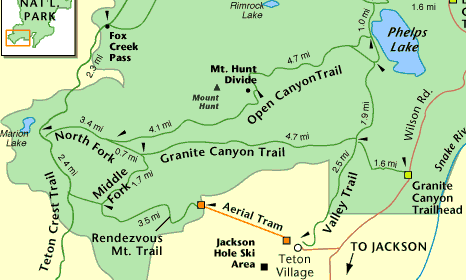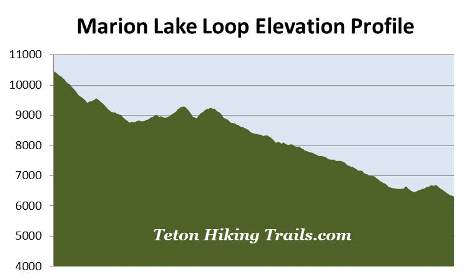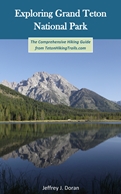
Marion Lake Loop
| Trail Features: | Panoramic Views, Lake, Wildflowers | 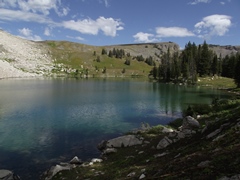 |
|||
| Trail Location: | Aerial Tram - Teton Village | ||||
| Roundtrip Length: | 16.6 Miles | ||||
| Trailhead Elevation: | 10,450 Feet | ||||
| Total Elevation Gain: | 1525 Feet | ||||
| Avg. Elev Gain / Mile: | 184 Feet | ||||
| Highest Elevation: | 10,450 Feet | ||||
| Trail Difficulty Rating: | 19.65 (strenuous) | ||||
| Parking Lot Latitude | 43.58768 | ||||
| Parking Lot Longitude | -110.82764 | ||||
Trail Description:
The Marion Lake Loop in Grand Teton National Park begins from the Aerial Tram in Teton Village. Hikers will have to take the tram up to the summit of Rendezvous Mountain where the actual hiking begins, thus avoiding the 4139 feet of vertical climbing. A fee is charged for the 12-minute tram ride.
This hike begins from the top of Rendezvous Mountain, visits Marion Lake, and then traverses back down the valley via the Granite Canyon Trail. Hikers will then return to Teton Village via the Valley Trail.
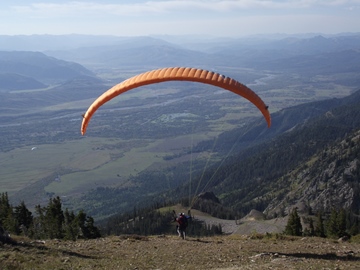 As you might expect, the views from the summit area are quite spectacular. You'll be able to see much of Jackson Hole, Jackson Lake, the Gros Ventre Mountains, as well as Grand Teton towards the north. 10,927-foot Rendezvous Peak will be the prominent mountain towards the southeast. You may even see a few paragliders taking off from the summit area.
As you might expect, the views from the summit area are quite spectacular. You'll be able to see much of Jackson Hole, Jackson Lake, the Gros Ventre Mountains, as well as Grand Teton towards the north. 10,927-foot Rendezvous Peak will be the prominent mountain towards the southeast. You may even see a few paragliders taking off from the summit area.
After disembarking from the tram and soaking-in the stunning views, walk to the end of the platform and turn left to begin your hike. Hikers will then proceed down a steep gravel service road for just over four-tenths of a mile. The main service road makes a turn towards the left here, while another rough gravel road splits-off and continues straight ahead. Follow this side road as it traverses atop a ridgeline for roughly 0.15 miles, until reaching a sign that indicates the official start of the Rendezvous Mountain Trail. This will be the first trail sign since departing the tram that will indicate you're on the correct route.
Shortly after turning onto the Rendezvous Mountain Trail you'll pass a sign marking the Grand Teton National Park boundary. From here the trail descends rapidly through an evergreen forest, dropping almost a thousand feet in roughly eight-tenths of a mile.
At the bottom of the descent the trail immediately begins a moderate climb through fairly open terrain. After a short distance it levels out a bit where you'll likely notice a series of mountains off towards the north. The most prominent peak in this group is 10,783-foot Mt. Hunt.
The trail continues to pass through predominantly open terrain that offers sweeping views of the surrounding mountains. At roughly 3.7 miles hikers will reach the Middle Fork Cutoff Trail junction. The Rendezvous Mountain Trail continues along the right fork, which leads down into Granite Canyon. Hikers should turn left onto the Middle Fork Cutoff Trail to proceed towards Marion Lake.
From the junction the Middle Fork Cutoff Trail begins by traveling across flat terrain, but eventually becomes a mild grade as it approaches the Teton Crest Trail.
At just over 4.3 miles hikers will arrive at the Teton Crest Trail junction. A turn to the left would lead you up to Moose Creek Divide. To continue towards Marion Lake hikers should turn right here.

From the junction the Teton Crest Trail traverses along the upper portions of Granite Canyon. This segment of the route travels over some fairly steep terrain, while losing and gaining elevation twice along the way to Marion Lake. Fortunately this section of trail also travels through open terrain that offers sweeping views of the surrounding landscape. The upper canyon area is also known for its spectacular wildflower displays. Although most were pretty much spent, there were still quite a few varieties left during our early-September hike.
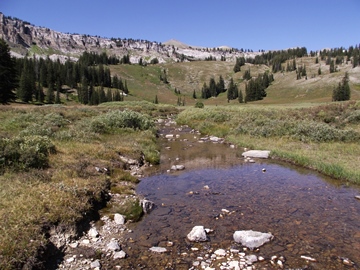 Soon the trail drops down to the Middle Fork of Granite Creek. After ascending the other side of the valley 10,537-foot Housetop Mountain will stand directly in front of you. The prominent mountain just to the right of Housetop is 10,031-foot Spearhead Peak.
Soon the trail drops down to the Middle Fork of Granite Creek. After ascending the other side of the valley 10,537-foot Housetop Mountain will stand directly in front of you. The prominent mountain just to the right of Housetop is 10,031-foot Spearhead Peak.
Almost immediately the trail begins descending again, dropping rapidly into the North Fork of Granite Creek valley. Near the bottom, at roughly 5.9 miles, hikers will arrive at the Granite Canyon Trail junction. To continue towards Marion Lake hikers should proceed straight ahead. The lake is roughly six-tenths of a mile away from this junction.
As you begin the final climb towards the lake you’ll enjoy some great views looking down Granite Canyon. You'll even be able to see Jackson Hole and the Gros Ventre Mountains in the far off distance.
At just over 6.4 miles hikers will finally reach the top of the ridge, and shortly thereafter, will arrive at the southern shore of Marion Lake. This beautiful subalpine lake lies in a cirque basin below the summit of 10,537-foot Housetop Mountain. If you wish to see some alternate views of the surrounding terrain, the Teton Crest Trail continues to the eastern end of the lake. Also, just east of the lake is another large meadow that offers spectacular wildflower displays. Arguably one of the best times to visit this area is in late July when the wildflowers are at peak bloom.
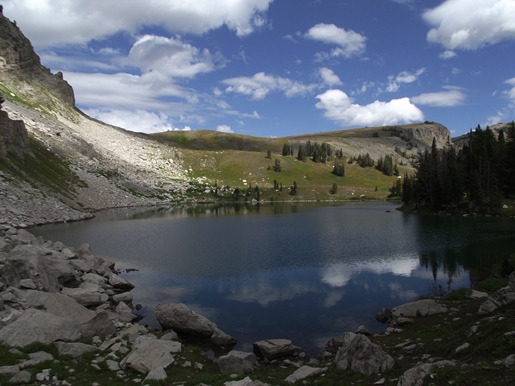
Hikers should note that snow can linger in this area until late July. Early season hikers should check with a ranger on conditions before deciding to hike this trail.
From the lake hikers will have to retrace their steps back down to the Granite Canyon Trail junction. Here you'll turn left onto the Granite Canyon Trail to continue towards Teton Village, which is still another 9.4 miles away from this junction.
As you descend from the junction the trail briefly re-enters the forest. The upper portion of the Granite Canyon Trail alternates between forested areas and large open meadows with expansive views. The upper canyon area is also known for its exceptional wildflower displays during the early-to-mid summer time period. Even in early September we still saw several varieties along this stretch of trail, including several white columbines. Hikers will also pass through several areas with high brush, including willows, which may be good places to spot moose. Since this is also prime bear habitat, be sure to make a lot of noise, especially where visibility is low. You should also consider carrying bear spray.
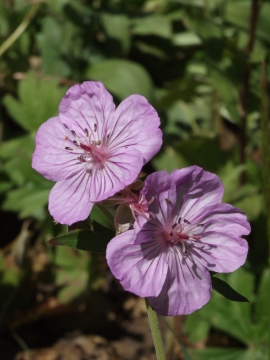

The trail descends along a mild grade, and for the most part, isn't nearly as rocky or rugged as some of the other canyons in this park. At roughly 8.25 miles hikers will reach the Open Canyon Trail, which branches off to the left and heads towards Mt. Hunt Divide. Hikers should proceed straight ahead at this junction.
At just over 9 miles you'll pass the Upper Granite Canyon Patrol Cabin, which was built by the Civilian Conservation Corps in 1935. After decades of slow deterioration the cabin was finally rehabilitated in 2013. Today the site is listed on the National Register of Historic Places.
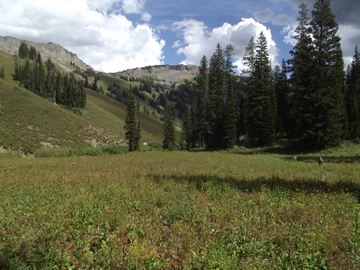 Just beyond the cabin hikers will arrive at the Rendezvous Mountain Trail junction. To continue towards Teton Village hikers should proceed straight ahead here as well.
Just beyond the cabin hikers will arrive at the Rendezvous Mountain Trail junction. To continue towards Teton Village hikers should proceed straight ahead here as well.
As you proceed down the canyon 8426-foot Apres Vous Peak will be the prominent mountain on your right. This peak also stands at the mouth of Granite Canyon.
The trail continues to meander in and out of open terrain and wooded areas as you proceed towards the lower canyon. During this stretch you'll have several opportunities for spotting moose in the willow-choked creek below the trail.
At just over 13.8 miles hikers will reach the Valley Trail. To continue towards Teton Village you should turn right here. Shortly thereafter the trail crosses over Granite Canyon Creek, and at 14 miles hikers will arrive at the Granite Canyon Trail split. To continue towards Teton Village you should veer to the right at this junction as well.
The Valley Trail is a pleasant hike through a mixed forest. For the most part it travels over relatively flat terrain, however, there are a couple of short climbs that make things a little more interesting before returning to the trailhead.
At roughly 15.6 miles the trail reaches the Grand Teton National Park boundary and begins passing through private property. A short distance later the Valley Trail reaches a gravel road. Hikers should turn left onto this road to continue towards Teton Village. From this point forward trail signage becomes a little confusing, and references to the Valley Trail end. You will now follow two mountain bike trails, the Saratoga Loop and the Summit Trail, to return back to Teton Village. The Summit Trail continues down a ski lift service road where you'll travel between the Apres Vous Ski Lift on one side, and a couple of private homes on the other. Soon the road reaches the outskirts of Teton Village. Simply look for the aerial tram to return back to the parking area.
Hikers should always be aware of lightning risk while hiking in the Grand Tetons, especially at higher elevations. As a general rule of thumb you should plan to turnaround before noon in order to avoid the notorious afternoon thunderstorms that frequent the mountains during the summer months. Hikers should also be prepared for extreme sun exposure, wind, cool temperatures, and rapidly changing weather conditions while on the trail. Make sure you have the proper gear with you, and know what safety precautions you need to consider beforehand.
